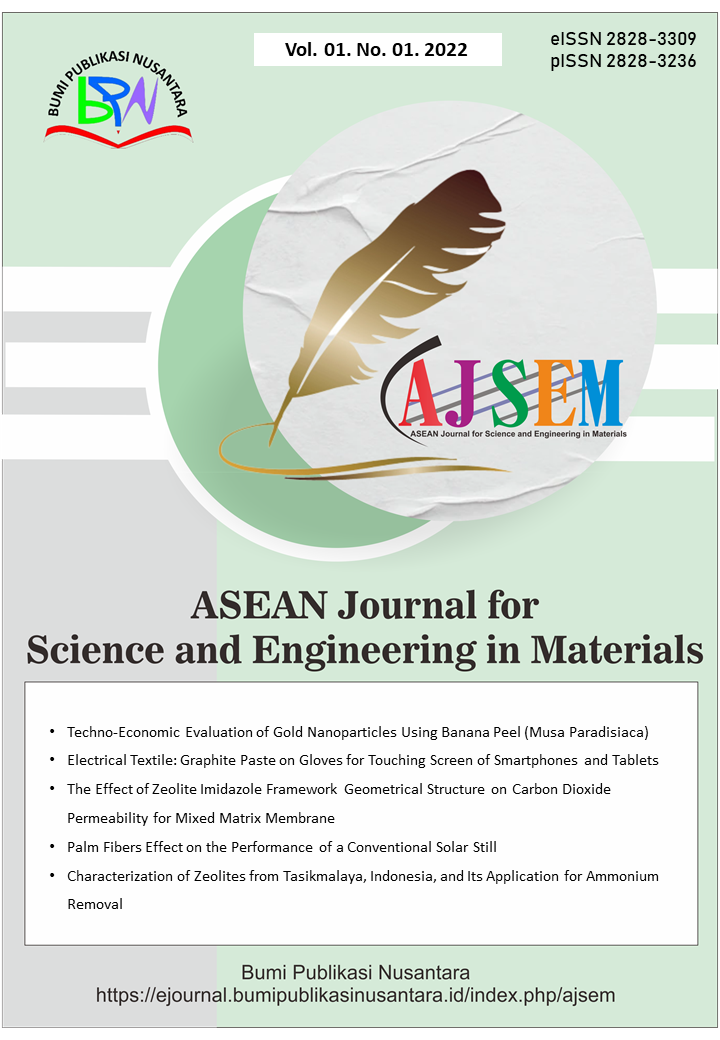Techno-Economic Evaluation of Gold Nanoparticles Using Banana Peel (Musa Paradisiaca)
 ), Salma Rahmadianti(2), Kanthi Pawening Tyas(3), Gabriela Chelvina Santiuly Girsang(4), Asep Bayu Dani Nandiyanto(5), Muhammad Roil Bilad(6),
), Salma Rahmadianti(2), Kanthi Pawening Tyas(3), Gabriela Chelvina Santiuly Girsang(4), Asep Bayu Dani Nandiyanto(5), Muhammad Roil Bilad(6),
(1) Universitas Pendidikan Indonesia
(2) Universitas Pendidikan Indonesia
(3) Universitas Pendidikan Indonesia
(4) Universitas Pendidikan Indonesia
(5) Universitas Pendidikan Indonesia
(6) University Brunei Darussalam
 Corresponding Author
Corresponding Author
Abstract
Keywords
References
Ashok, B., Bhagyashree, J., Ameeta, R. K., and Smita, Z. (2010). Banana peel extract mediated synthesis of gold nanoparticles. Colloids and Surfaces B: Biointerfaces, 80(2012), 45-50.
Chanakya, H. N., Sharma, I., and Ramachandra, T. V. (2009). Micro-scale anaerobic digestion of point source components of organic fraction of municipal solid waste. Waste Management, 29(4), 1306-1312.
Daraee, H., Eatemadi, A., Abbasi, E., Fekri Aval, S., Kouhi, M., and Akbarzadeh, A. (2016). Application of gold nanoparticles in biomedical and drug delivery. Artificial Cells, Nanomedicine, and Biotechnology, 44(1), 410-422.
De Araújo Júnior, R. F., de Araújo, A. A., Pessoa, J. B., Neto, F. P. F., da Silva, G. R., Oliveira, A. L. C. S., de Carvalho, T. G., Silva, H. F.O., Eugenio, M., Sant'Anna, C., and Gasparotto, L. H. S. (2017). Anti-inflammatory, analgesic and anti-tumor properties of gold nanoparticles. Pharmacological Reports, 69(1), 119-129.
Deokar, G. K., and Ingale, A. G. (2016). Green synthesis of gold nanoparticles (Elixir of Life) from banana fruit waste extract–an efficient multifunctional agent. RSC Advances, 6(78), 74620 - 74629.
Dreaden, E. C., Alkilany, A. M., Huang, X., Murphy, C. J., and El-Sayed, M. A. (2012). The golden age: gold nanoparticles for biomedicine. Chemical Society Reviews, 41(7), 2740-2779.
Emaga, T. H., Andrianaivo, R. H., Wathelet, B., Tchango, J. T., and Paquot, M. (2007). Effects of the stage of maturation and varieties on the chemical composition of banana and plantain peels. Food Chemistry, 103(2), 590-600.
Emaga, T. H., Ronkart, S. N., Robert, C., Wathelet, B., and Paquot, M. (2008). Characterisation of pectins extracted from banana peels (Musa AAA) under different conditions using an experimental design. Food Chemistry, 108(2), 463-471.
Kumar, C. G., Mamidyala, S. K., Sreedhar, B., and Reddy, B. V. (2011). Synthesis and characterization of gold glyconanoparticles functionalized with sugars of sweet sorghum syrup. Biotechnology Progress, 27(5), 1455-1463.
Kusrini, E., Aulia, M., Widiantoro, A. B., Nurani, Y., and Mamat, M. (2018, October). Synthesis and Characterization of Natural, Pectin and Activated Carbon as Low Cost Potential Adsorbents from Kepok Banana Peels (Musa paradisiaca L.). IOP Conference Series: Materials Science and Engineering, 440(1), 012030
Maulana, M. I., and Nandiyanto, A. B. D. (2019). Economic evaluation of different solvents in the production of LaCoO3 nanoparticles prepared by the co-precipitation method. International Journal of Advanced Smart Convergence, 1(4), 7-15.
Nandiyanto, A. B. D., and Ragadhita, R. (2019). Feasibility study in the production of zinc imidazole framework particles. Journal of Engineering Research, 7, 36-49.
Qiao, J., and Qi, L. (2021). Recent progress in plant-gold nanoparticles fabrication methods and bio-applications. Talanta, 223, 121396.
Raj, V., Jaime, R., Astruc, D., and Sreenivasan, K. (2011). Detection of cholesterol by digitonin conjugated gold nanoparticles. Biosensors and Bioelectronics, 27(1), 197-200.
Silva, C. O., Rijo, P., Molpeceres, J., Ascensão, L., Roberto, A., Fernandes, A. S., Gomes, R., Coelho, J. M. P., Gabriel, A., Vieira, P., and Reis, C. P. (2016). Bioproduction of gold nanoparticles for photothermal therapy. Therapeutic Delivery, 7(5), 287-304.
Suganya, K. U., Govindaraju, K., Kumar, V. G., Karthick, V., and Parthasarathy, K. (2016). Pectin mediated gold nanoparticles induces apoptosis in mammary adenocarcinoma cell lines. International Journal of Biological Macromolecules, 93, 1030-1040.
Tsuzuki, T. (2009). Commercial scale production of inorganic nanoparticles. International Journal of Nanotechnology, 6(5-6), 567-578.
Vijayakumar, S., Vaseeharan, B., Malaikozhundan, B., Gopi, N., Ekambaram, P., Pachaiappan, R., Velusamy, P., Murugan, K., Benelli, G., Suresh Kumar, R., and Suriyanarayanamoorthy, M. (2017). Therapeutic effects of gold nanoparticles synthesized using Musa paradisiaca peel extract against multiple antibiotic resistant Enterococcus faecalis biofilms and human lung cancer cells (A549). Microbial Pathogenesis, 102, 173- 183.
Zahra, F., Utami, F. A., Girsang, G. C. S., Mulya, S. Z. M. S., Fentiana, V. D., Putri, Y. K., and Nandiyanto, A. B. D. (2020). Economic evaluation of zinc oxide nanoparticle production through green synthesis method using Cassia fistula plant extract. International Journal of Energetica, 5(2), 18-24
Zhang, X. (2015). Gold nanoparticles: recent advances in the biomedical applications. Cell Biochemistry and Biophysics, 72(3), 771-775.
Article Metrics
Abstract View : 1527 times
: 1527 times Download : 902 times
Download : 902 times
Refbacks
- There are currently no refbacks.
Copyright (c) 2022 Bumi Publikasi Nusantara

This work is licensed under a Creative Commons Attribution-ShareAlike 4.0 International License.









